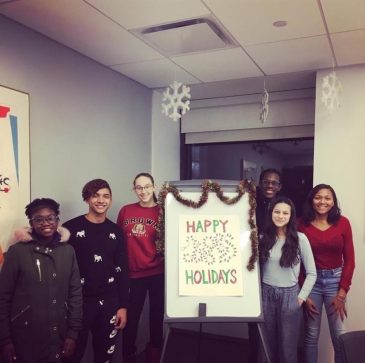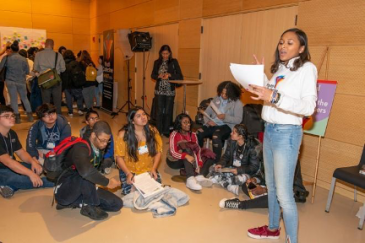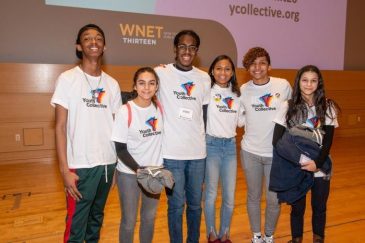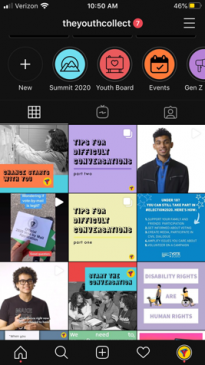Young people want to be heard. They want adults to hear their stories, consider their ideas, and value them as partners in finding solutions for issues facing their communities.

The WNET Group is listening.
Started in 2018, Youth Collective is the WNET Group’s Generation Z media and education initiative that provides a space for young people to discuss issues they care about. Through youth media and convenings like an annual youth summit, we aim to amplify youth voice and ground our work in ethics education, with support from the Prindle Institute for Ethics.
One of our goals is to prioritize Next Gen Public Media’s “By/With/For Youth” principles. In an effort to give youth more direct input into our initiatives, we have partnered with consulting firms and media agencies who specialize in reaching the elusive 13-24-year-old community. At an even more participatory level, in 2019 we established a youth advisory board to help build and steer our annual Youth Collective summit.
Advisory Board
Our first Youth Advisory Board included 12 high school students from across the New York metro area, who met regularly for pizza, discussion, and constructive input.

The board’s main task? Helping to shape our second annual summit. The March 2020 convening brought together 200 NYC, Long Island, and New Jersey high school students for a day of workshops, speakers, and conversation about what it means to be civically engaged.
Our advisors were an integral part of the summit planning process. They helped us to select the theme—“Beyond the Vote”—and develop the structure of the summit.
Inspired by our friends at YVote, a part of Next Gen Politics, our advisors researched, planned, and led “activation stations” designed to spark thoughtful conversations about four election year issues: Immigration, Climate Change, Gender Rights, and Mental Health. For example, at the immigration station, students played a Jeopardy-style game using questions from the U.S. citizenship test, then discussed barriers to citizenship and what it means to be “American.”

Our advisors guided big decisions as well as finer points. (Are water bottles a cool giveaway? Do people like hoodies or zip-up sweatshirts more? The answers: Yes, and hoodies, please.) This year, we look forward to letting them take an even larger lead in the year’s activities and planning process.
JUV Consulting, a professional firm run completely by Gen Z consultants age 25 and younger, was our thought partner when it came to summit planning. Most significantly, they connected us with incredible youth leaders, many of whom were not on our radar—enabling us to bring in panelists and speakers who could relate authentically to the Youth Collective community (including the inspiring and influential Ziad Ahmed, Deja Foxx, Chelsea Miller, and Matt Post).

We also collaborated closely with Adolescent Content, a media agency that specializes in reaching Gen Z through marketing, advertising, and original content. Adolescent helped develop a fresh brand for Youth Collective, bringing in their Gen Z network to test for branding appeal.
Adolescent’s network of Gen Z creators have pitched and produced content designed for our audience on social media. They’ve been invaluable as we work to feature diverse voices and content, as well as authentically growing our network and audience of young people.
In addition, we work with young people to create videos that capture Youth Collective’s mission and work through our partnership with Reel Works, a Brooklyn-based organization that trains teens in media production, then hires them to create media for clients. Reel Works has been our go-to crew to cover our annual summit and produce videos for our YouTube channel.
Actively collaborating with Gen Z to create media “by/with/for youth” guides all of our work with Youth Collective. We continue to learn from young people as we expand our audience and our own work in new, exciting ways.
 Kristina Kirtley is a Senior Producer for Content and Youth Engagement, Kids’ Media and Education at WNET, New York’s flagship public media company. As a former high school English teacher, she spent years working directly with students and was thrilled to help create Youth Collective, WNET’s Gen Z media and engagement initiative, to again work directly with young people. In addition to Youth Collective, she also develops meaningful education resources and professional development for various productions like American Masters, Great Performances, and the history gaming series Mission US. Kristina graduated from Stanford University and City College as part of the New York City Teaching Fellows Program.
Kristina Kirtley is a Senior Producer for Content and Youth Engagement, Kids’ Media and Education at WNET, New York’s flagship public media company. As a former high school English teacher, she spent years working directly with students and was thrilled to help create Youth Collective, WNET’s Gen Z media and engagement initiative, to again work directly with young people. In addition to Youth Collective, she also develops meaningful education resources and professional development for various productions like American Masters, Great Performances, and the history gaming series Mission US. Kristina graduated from Stanford University and City College as part of the New York City Teaching Fellows Program.
 Michelle Chen is Senior Producer, Kids Media and Education at WNET, where she has been creating content for public television and digital platforms since 2004. She has received Emmy awards for her work as a producer on the PBS KIDS series Cyberchase and the multiplatform project, Get the Math. She serves as senior producer onMission US, which received the Japan Prize for Educational Media and the Games for Change Award for Most Significant Impact, and has worked on a variety of other kids’ media and education projects for WNET, including Youth Collective, the PBS KIDS video and gaming series Oh Noah!, and Parenting Minutes. Michelle graduated from Harvard University.
Michelle Chen is Senior Producer, Kids Media and Education at WNET, where she has been creating content for public television and digital platforms since 2004. She has received Emmy awards for her work as a producer on the PBS KIDS series Cyberchase and the multiplatform project, Get the Math. She serves as senior producer onMission US, which received the Japan Prize for Educational Media and the Games for Change Award for Most Significant Impact, and has worked on a variety of other kids’ media and education projects for WNET, including Youth Collective, the PBS KIDS video and gaming series Oh Noah!, and Parenting Minutes. Michelle graduated from Harvard University.
 Hannah Dawe is the Learning Partnerships and Engagement Specialist in Kids’ Media and Education at WNET. She works to connect and support educators through media projects, community engagement, and professional development. She was the education project lead for NJTV Learning Live, WNET’s instructional series to help kids learn remotely, created in spring 2020 in response to COVID-19. She works on a variety of other projects, including producing content for PBS LearningMedia and Youth Collective. Before WNET, Hannah worked as a professional actor, director, and teaching artist in Chicago and New York City. She graduated from Northwestern University and the Harvard Graduate School of Education.
Hannah Dawe is the Learning Partnerships and Engagement Specialist in Kids’ Media and Education at WNET. She works to connect and support educators through media projects, community engagement, and professional development. She was the education project lead for NJTV Learning Live, WNET’s instructional series to help kids learn remotely, created in spring 2020 in response to COVID-19. She works on a variety of other projects, including producing content for PBS LearningMedia and Youth Collective. Before WNET, Hannah worked as a professional actor, director, and teaching artist in Chicago and New York City. She graduated from Northwestern University and the Harvard Graduate School of Education.